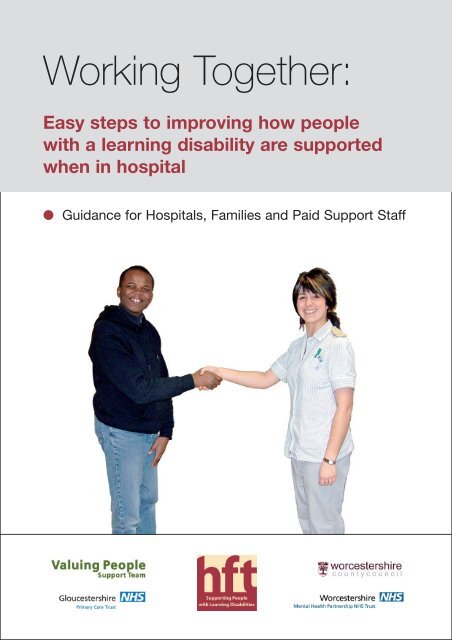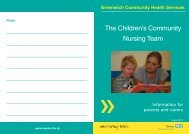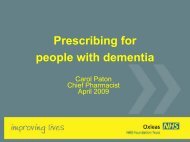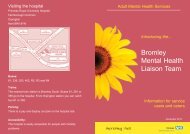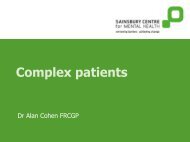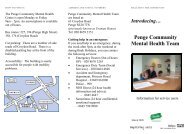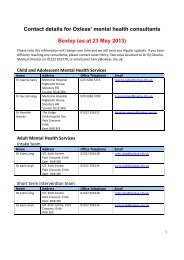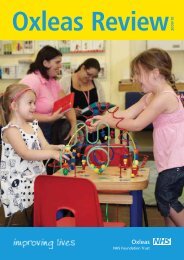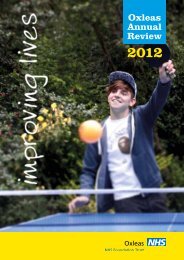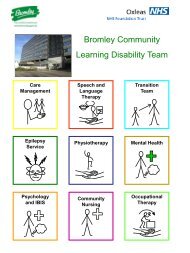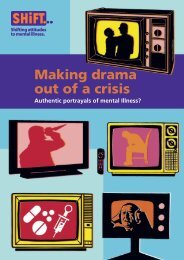Working Together: - Hillingdon Hospital NHS Trust
Working Together: - Hillingdon Hospital NHS Trust
Working Together: - Hillingdon Hospital NHS Trust
- No tags were found...
Create successful ePaper yourself
Turn your PDF publications into a flip-book with our unique Google optimized e-Paper software.
<strong>Working</strong> <strong>Together</strong>:Easy steps to improving how peoplewith a learning disability are supportedwhen in hospital● Guidance for <strong>Hospital</strong>s, Families and Paid Support Staff
AcknowledgementsHFT would like to thank the following people who contributed to this work:Jenny Harkness, Social Worker, HFTMargaret Power, Family Carer Support Service, HFTSue Picton, Family CarerSue Turner, Valuing People Support TeamCrispin Hebron, HFTRobina Mallett, Family Carer Support Service, HFTKevin Elliott, Gloucestershire PCTLin Blight, Bristol PCTJane Merrifield, Bristol Royal InfirmaryKate Robinson, Worcestershire Partnership <strong>NHS</strong> <strong>Trust</strong>This guide can be downloaded from:http://www.hft.org.uk/p/4/121/<strong>Working</strong>_<strong>Together</strong>.htmlor http://valuingpeople.gov.uk/dynamic/valuingpeople118.jspFor further information, contact:Crispin HebronTel: 01452 312356 (office) / 07795 306215 (mobile)Cover photo © 2006 Photosymbols Ltd. All rights reserved.Layout: Third Column (020 8892 4255)<strong>Working</strong> <strong>Together</strong>: Guidance for <strong>Hospital</strong>s, Families and Paid Support Staff • page 2
ContentspageIntroduction ________________________________________________________________ 4Section 1 What you can be doing now (before admission) __________________ 7Steps for family carers and/or paid support staff ____________________ 7Steps for hospitals_______________________________________________ 9Section 2 What you can do when a hospital admission is needed ___________ 10Steps for family carers and/or paid support staff ____________________ 10Steps for hospitals_______________________________________________ 11Section 3 What you can do during the hospital stay ________________________ 13Steps for family carers and/or paid support staff ____________________ 13Steps for hospitals_______________________________________________ 13Section 4 What you can do when the hospital stay is ending ________________ 15Steps for family carers and/or paid support staff ____________________ 15Steps for hospitals_______________________________________________ 15Where to find further information_____________________________________________ 17Points on consent to consider before any admission meeting __________________ 19Checklist for admission meeting _____________________________________________ 20The Traffic Light <strong>Hospital</strong> Assessment________________________________________ 23The Risk, Dependency and Support Assessment ______________________________ 27<strong>Working</strong> <strong>Together</strong>: Guidance for <strong>Hospital</strong>s, Families and Paid Support Staff • page 3
IntroductionGoing into hospital, for whatever reason, can be frightening, confusing and stressful;people are often unsure of what to expect or how they will cope, and the language used bydoctors and nurses can be hard to understand. It is a time when everyone will feel vulnerable.For people with a learning disability it is likely to be even more complicated for a widerange of reasons. They are likely to find it more difficult to communicate natural anxieties,or explain any pain or discomfort they may be in. They may have difficulty in adjusting tothe hospital environment and routines. The hospital staff may not know or understand theircognitive, health and personal care needs. They may also have had poor experiences ofhealthcare in the past. Such vulnerability is likely to be further increased by other factorslike epilepsy, mental illness, sensory impairment or increased likelihood of choking – all ofwhich are more common amongst people with learning disabilities.These problems have been known about for some time and have been highlighted in anumber of reports such as Treat Me Right (Mencap 2004) and Death by Indifference(Mencap 2007). The Government has responded in a number of ways, through legislationsuch as the Disability Discrimination Act (2005), and an Independent Inquiry into access tohealthcare for people with learning disabilities, led by Sir Jonathan Michael. The resultingreport, Healthcare for All (2008), has 10 important recommendations which concern the‘reasonable adjustments’ that are needed to make health care services as accessible topeople with learning disabilities as they are to other people. The 10 year Carers’ StrategyCarers at the Heart of 21st Century Families and Communities (2008) expects carers to bepartners in diagnosis, care and discharge planning alongside <strong>NHS</strong> and Social Service staff.This guidance is based on three of the key points at the heart of the many recommendationsthat have emerged from recent documents about the potential health inequalities thatpeople with learning disabilities face:●●●Like everyone else, people with learning disabilities should get the helpthey need from health services, though this may mean that reasonableadjustments need to be made.Health professionals should listen more to the families and support staff ofpeople with learning disabilities because they usually know most about themand the support they need.Health staff should not rely on relatives or paid carers of people with learningdisabilities to provide care whilst they are in hospital without considering theirneeds and supporting them appropriately.The best way to help anyone to manage the natural stresses of going into hospital is forthem to have the support of people who know and care about them; we all need this.As many healthcare staff have very limited knowledge about learning disabilities, such<strong>Working</strong> <strong>Together</strong>: Guidance for <strong>Hospital</strong>s, Families and Paid Support Staff • page 4
support becomes even more important for someone with a learning disability. Too often,where a person has additional support needs during their stay in hospital, it is eitherexpected, or assumed, that family members will provide this or, if the person has some paidsupport, this will continue in hospital. Occasionally, additional nursing support is providedby the hospital to meet such needs, (sometimes called ‘specialing’) but this is usuallyprovided by a bank or agency nurse who may not know the ward well, let alone the patient!This guidance has been produced by a working group of family carers, hospital staff,learning disability nurses and paid support staff, facilitated by HFT. Its aim is to help ensurethat people with learning disabilities get the right kind of support and effective treatmentduring their stay in hospital. Each person will have different needs and require differentlevels of support to help them cope and get the best out of their stay in hospital. It iscrucial therefore to carefully assess each person’s need for additional support and who isbest placed to provide it (most effectively).<strong>Hospital</strong>s have a clear ‘duty of equality’. This does not mean treating everybody the samebut rather that hospitals must make ‘reasonable adjustments’ to meet the needs of disabledpeople, because they are entitled to expect equality in the outcome of their hospital stay.<strong>Hospital</strong>s are also required to maintain the dignity of all disabled patients. For some peopleadditional support may be required to achieve these things as well as to maintain safetywhilst they are in hospital.Family members and/or paid care staff can make a major contribution to the effectivenessof treatment and support by providing medical histories and other important information.They can also help identify areas of risk and so reduce it. Sometimes they can also contributeto maintaining a patient’s safety and dignity whilst in hospital by providing additionalsupport. For example a family member or paid support worker is probably best placed toprovide expert advice regarding a learning disabled patient’s communication needs duringtheir stay. They may be able to reduce anxiety over a particular procedure, such as aninjection, or simply come in and help with the person’s evening meal should they need it.It is the hospital’s responsibility to fund any extra support over and above the individuallyfunded support ordinarily available to the person when in their own home. So, if a personusually has 2 hours individual support funded each day to help them at home, then thiscan usually be transferred to the hospital. However, if the person only has shared supporthours, where paid support is shared with other people, then this cannot be transferred andadditional support will have to be funded by the hospital to meet any identified additionalneeds and promote an equal outcome.Clear ways of recording key information about an individual with learning disability areimportant. One example of this is the Traffic Light <strong>Hospital</strong> Assessment developed byGloucestershire Partnership <strong>NHS</strong> <strong>Trust</strong> as a tool for communicating what hospital staff willneed to know about a patient with learning disabilities. You will find a copy of this onpages 23 to 26.In addition you will find a Risk, Dependency and Support Assessment on pages 27 to 33.<strong>Working</strong> <strong>Together</strong>: Guidance for <strong>Hospital</strong>s, Families and Paid Support Staff • page 5
The Risk, Dependency and Support Assessment was designed by the working group tofollow on from a record like the Traffic Light <strong>Hospital</strong> Assessment. It identifies risks (bothphysical risks and risks to the effective outcome of the hospital stay) and what additionalsupport may be required to address them. The Risk, Dependency and Support Assessmentoffers a framework to help in the negotiation for any additional support to reduce risk, byidentifying who is best able to provide that support. This then gives the hospital a clearframework to evidence where further funding is required. It is recommended that the Risk,Dependency and Support Assessment is used by the nurse in charge of the ward alongsidethe patient and those who know the patient best (e.g. paid support staff/family members/advocates).Family carers, paid support staff and hospital staff should be working together to achievethe best outcomes for people with learning disability. In the next part of the guide foursections explain what people from each group should be doing 1) before admission,2) at or around admission time, 3) during and 4) at the end of a hospital stay. At the backof the booklet you will find a Checklist for admission meeting, plus links to other sourcesof useful information, as well as the Traffic Light <strong>Hospital</strong> Assessment and the Risk,Dependency and Support Assessment forms.<strong>Working</strong> <strong>Together</strong>: Guidance for <strong>Hospital</strong>s, Families and Paid Support Staff • page 6
●●●Paid support staff could identify one person from their team to take a lead on preparingfor any hospital admission – ensuring assessments are done, contacting hospitals etc.Should you need it there is also the Independent Complaints Advocacy Service (ICAS),a statutory service commissioned by the Department of Health to support peoplethrough the <strong>NHS</strong> complaints procedure. ICAS is independent of any hospital andcontracted out on a regional basis to good advocacy services.List the above contacts now and keep them with the other information you have gathered.Might additional support be needed in hospital?●●The Traffic Light <strong>Hospital</strong> Assessment mentioned above provides information on aperson’s needs: the Risk, Dependency and Support Assessment (given on pages27 to 33) maps out how those needs can be met whilst the person is in hospital. If youbecome familiar with this assessment now you will be able to use it with the hospitalwhenever an admission is needed.Consider how much time you could realistically spend supporting the person inhospital – are there other relatives, friends or staff who could be called upon?Do you know about consent?●●●You should be aware that under the Mental Capacity Act only the individual themselves (ifthey have capacity to) or the Decision Maker (if the person lacks capacity) can give consentto medical treatment. Relatives and paid staff have responsibilities, along with medicalstaff, to help someone understand about any Best Interests Decisions. Those close to anindividual will have some relevant experience of how they are supported to make decisionsand communicate their views in other aspects of their life. However, if it is decided thatthe person lacks capacity to make a particular decision about treatment, and there is timeto, a Best Interests Meeting must be held. Family members and support staff should beinvited to give their views, based on their knowledge of the person, but they do not haveresponsibility for medical decisions. These will be made by the person doing the procedure.Paid staff should be aware of their duties under the Mental Capacity Act by reading theMCA Code of Practice and/or Making Decisions: a guide for people who work in healthand social care. They should also do what they can to provide family members withaccurate, user friendly information too. They could do this by signposting relatives to, or– better still – having copies of Making Decisions – a guide for family, friends and otherunpaid carers ready to give to relatives. You can download and/or order these andother helpful documents by visiting www.publicguardian.gov.uk. For more informationabout the Mental Capacity Act, Best Interests meetings and use of Independent MentalCapacity Advocates see the Where to find further information section.You can provide staff at the hospital with some of the useful information about people withlearning disabilities listed at the back of this booklet or keep copies of booklets you thinkare especially relevant so you can lend them to hospital staff if an admission is necessary.<strong>Working</strong> <strong>Together</strong>: Guidance for <strong>Hospital</strong>s, Families and Paid Support Staff • page 8
Steps for hospitals to prepare for the admissionof patients with a learning disability●●●●●●●●●●●●Develop your own policies for when a person with a learning disability is admitted,ensuring these include accepting and supporting relatives and paid support staff togive the help they are offering the patient. Good examples of hospital policies areavailable from the A2A network listed in the Where to find further information section.Monitor how many patients with a learning disability are admitted and record how wellthe admission and the additional support went.Look at the information detailed in the Where to find further information section atthe back of this booklet and make it available to all staff.Produce easy to understand information about the hospital and make it available topeople coming to the hospital whether as an outpatient or inpatient. Local People Firstgroups may be able to help with the drafting of this information.Have easy to understand information about different procedures(www.easyhealth.org.uk, a web site run by Generate, a charity working with peoplewho have learning disabilities, using Department of Health funding, provides someuseful information that could help with this).Gather resources that can help when a person with a learning disability is admittedand ensure that its existence is advertised. Where should this be lodged?Provide training to staff on learning disabilities; local family carers and people withlearning disabilities may be able to help with this.Train staff on how to use any tool adopted by the hospital for assessing and alertingstaff to the support needs of a patient with learning disabilities (eg the GloucestershirePartnership <strong>NHS</strong> Traffic Light <strong>Hospital</strong> Assessment).Make available and provide training on the Risk, Dependency and Support Assessmentand ensure that all nursing staff are familiar with it.Arrange the funding systems to pay for additional support from those who knowindividual patients who have a learning disability, rather than use agency nurses.Identify a member of staff on each ward or department to take a lead on support forpeople with learning disabilities in their area.Ensure staff are up to date with what the Mental Capacity Act says about informeddecision making, consent, best interests meetings, etc. (See above Do you knowabout consent? under the steps for family carers and/or paid carers in this section fora brief introduction. (You will find more information about this in the Where to findfurther information section at the back of this booklet).<strong>Working</strong> <strong>Together</strong>: Guidance for <strong>Hospital</strong>s, Families and Paid Support Staff • page 9
1 2 3 42 What you can do when ahospital admission is neededSteps for family carers and/or paid support staffat or around admission time●●●As soon as you know someone is going into hospital make sure that the member ofstaff at the hospital who takes a lead on learning disabilities is aware of the admission.This may be the Learning Disability Liaison Nurse or someone else. Hopefully they willbe able to attend an admission meeting. The Patient Advice and Liaison Serviceshould also be informed.The person will need to be supported to understand what to expect – what will happento them, how they may feel, etc. A visit to the ward before the admission can be veryhelpful. You can introduce yourself and the person concerned to staff. You can alsofind out where bathrooms, communal areas, rest areas, car parking, telephones,gardens and other services are in the hospital.For unplanned admissions both of the above suggestions of good practice shouldhappen at the earliest opportunity.Giving and receiving information●●●●●For planned admissions it is best to contact the Learning Disability Liaison Nurse(where available) or the learning disability lead nurse for the ward or department (wherethere is no Learning Disability Liaison Nurse) and ask for a pre-admission meeting.For unplanned admissions, arrange for a meeting to take place at the earliestopportunity after admission.Where possible the person with a learning disability should be part of this meeting.Provide the department at the hospital with the information that you have, summarisedif possible in a way that will be useful to hospital staff, perhaps using a tool such asthe Traffic Light Assessment.There is a check list of things that would need to be discussed at the meeting at theback of this booklet; it will include issues of consent and best interests, covered by theMental Capacity Act. (You will find more information available about this in the earliersection for carers and in the Where to find further information section at the back ofthis booklet). Issues of confidentiality will also need to be discussed at the pre-admissionmeeting, as well as who should be informed of what.<strong>Working</strong> <strong>Together</strong>: Guidance for <strong>Hospital</strong>s, Families and Paid Support Staff • page 10
●●●●●●Think about what information YOU would like to get from this meeting. Does thehospital have the equipment and the space needed for hoists, wheelchairs, etc that theperson needs? Do you need to be finding out about any equipment that might beneeded on discharge, some of which may take a while to arrange – who will organisethis and when? If there are unexpected difficulties with medication, appliances, etconce the person is back where they live, who should you, as their carers, contact foradvice if the GP is unable to help? How will any nicotine addiction be managed – willpatches be used? Make a list of your own questions, including your likely needs foraccommodation, sustenance, toilets/showers etc (you could use space on theChecklist for admission meeting on pages 21 and 22, where you will also find somesuggested questions compiled by families to help you).Work with the ward to complete the Risk, Dependency and Support Assessment inorder to agree what additional support may be required and who is best to provide it.The decisions following completion of the Risk, Dependency and SupportAssessment should be shared with anyone else involved with the individual (includingtheir Local Authority through their care manager where appropriate).Help others to understand what is likely to happen or how you think the personmight respond, especially if you have been with them when they have been inhospital before.Find out how the ward runs; when are ward rounds (when the individual is likely toneed support with giving and receiving information, and you may have questions toask), meal times, staff handover times and visiting hours?Find out about any special parking arrangements, refreshment facilities, etc. Somehospitals run schemes such as free parking for carers. The Patient Advice and LiaisonService can help you here.Steps for hospitals when an admission for apatient with a learning disability is needed●●●●Host a pre-admission meeting for planned admissions with those who know thepatient best, using the checklist at the back of this booklet. Unplanned admissions willrequire this admission meeting to take place at the earliest opportunity.Use any assessment information provided by carers to make nursing care asappropriate as possible.Ensure that the ward team are informed and as prepared as possible for the admission.The ward team should introduce themselves to the patient and their carers and fullyexplain what will happen.<strong>Working</strong> <strong>Together</strong>: Guidance for <strong>Hospital</strong>s, Families and Paid Support Staff • page 11
●●●●●●●Work with those who know the patient best to fill out the Risk, Dependency andSupport Assessment so you can identify and agree what additional support may berequired, and who is best to provide it.Carry out further hospital risk assessments on any areas of likely risk identified in theRisk, Dependency and Support Assessment.The senior member of hospital staff with responsibility for patients with a learningdisability should be informed of the admission and the outcome of the Risk,Dependency and Support Assessment in order to authorise and secureappropriate funding.Paid support staff, with the help of families, are usually the best people to provide anyadditional support required during a hospital stay. The individual is used to them andthey are familiar with the support the individual needs. Ensure all staff concernedunderstand this and accept their presence.Agree practical arrangements such as parking, breaks, refreshments, etc with anyoneproviding additional support.Agree that someone who knows the individual and their communication well must bepresent when ward rounds happen.Remind staff to prevent groups of students from being present during ward rounddiscussions if this is likely to be unsatisfactory for the patient.<strong>Working</strong> <strong>Together</strong>: Guidance for <strong>Hospital</strong>s, Families and Paid Support Staff • page 12
1 2 3 43 What you can do during thehospital staySteps for family carers and/or paid support staffduring a hospital stay●●●●●●●●Provide any support that you have agreed as part of the Risk, Dependency andSupport Assessment.Contribute to any re-assessment of needs as required, using the Risk, Dependencyand Support Assessment, for example following surgery.Continue to help the person to understand procedures and progress etc.Provide information about how the person is responding to medication/treatmentfor the nurses’ handover meetings when they pass on information to nurses comingon shift.Try to make a point of talking to the senior member of staff on duty.Involve the Patient Advice and Liaison Service in any disagreements or concerns thatyou may have regarding the hospital stay.Help to identify what additional needs the person may have after their hospital stay.Inform the person’s Local Authority (where appropriate) of any needs that are likely tobe higher after the hospital stay.Steps for hospitals during a hospital stay for apatient with a learning disability●●●Continually explain procedures, medication, changes in condition or treatment andcheck that both the patient and any carers understand the information and have theopportunity to ask questions.Include family carers and/or paid support staff in the nursing handover, or at least seekinformation from them to share at the nursing handover.Undertake a reassessment of Risk, Dependency and Support needs whenever it isindicated that the patient may require more or less additional support.<strong>Working</strong> <strong>Together</strong>: Guidance for <strong>Hospital</strong>s, Families and Paid Support Staff • page 13
●●●Raise any concerns around paid support staff who are providing additional support asindicated by the Risk, Dependency and Support Assessment directly with the paidsupporter’s employing organisation.Help to identify any increased support needs the patient may have following theirhospital stay.Ensure any actions suggested by the pre-admission meeting are being undertaken,for example, has an Occupational Therapy assessment been booked so specialequipment will be available on discharge?<strong>Working</strong> <strong>Together</strong>: Guidance for <strong>Hospital</strong>s, Families and Paid Support Staff • page 14
1 2 3 44 What you can do when thehospital stay is endingSteps for family carers and/or paid support staffwhen it’s time for the person to leave hospital●●●●●●●Ask for a discharge planning meeting with ward staff and the Local Authority CareManager or <strong>Hospital</strong> Social Worker.Ask the person’s Local Authority to carry out an assessment of changed needsif required, so that the allocation of any additional funding required upon dischargeis available.Think about what will be needed at home, discuss this with the care manager or socialworker and confirm who will be doing what and when including how paid staff orfamily carers are to be involved.Find out about hospital transport for the person to get home if needed.Inform anyone who needs to know (other paid support staff etc) of any changed needsand what support may be required.Make sure everyone who needs to know is aware of when the person will be leavinghospital and who to contact if there are any concerns after discharge.Tell the hospital how you think the stay went, what worked well and any improvementsthat could be made. If possible, this is best done in writing. If it has gone well, write anote of thanks.Steps for hospitals when it’s time for the patientwith a learning disability to leave hospital●●Organise a formal discharge planning meeting wherever possible including familycarers and paid support staff.Inform the patient, family carers and paid support staff of any requirementsfollowing the patients hospital stay, such as bed rest or no lifting. This should includeany possible side effects of new medication and confirm what to do if anycomplications arise.<strong>Working</strong> <strong>Together</strong>: Guidance for <strong>Hospital</strong>s, Families and Paid Support Staff • page 15
●●●●Remember to check arrangements have been booked for any outstanding specialistassessments that may still be needed, such as Occupational Therapy.Inform the Community Learning Disability Team that the person will be leaving hospital.Organise transport if needed.Invite the patient, their family and paid support staff to give feedback on the hospitalexperience – what has gone well, what could be improved?<strong>Working</strong> <strong>Together</strong>: Guidance for <strong>Hospital</strong>s, Families and Paid Support Staff • page 16
● Where to find furtherinformationA2A, Access to Acute care: “A2A” – Access to Acute Care – Special Interest Group website: http://www.nnldn.org.uk/a2a/index.aspDepartment for Constitutional Affairs (2007) Mental Capacity Act 2005 Code of Practicecan be downloaded from:www.opsi.gov.uk/ACTS/acts2005/related/ukpgacop_20050009_en.pdfDepartment of Health (2008) Good practice in learning disability nursing: Department ofHealth – Publicationswww.library.nhs.uk/learningdisabilities/Page.aspx?pagename=HNAEU2008The Disability Rights Commission investigation into health inequalities for people withmental health issues and learning disabilities. Equal Treatment: Closing the Gap.This report is downloadable from:http://www.equalityhumanrights.com/en/publicationsandresources/Pages/DRCHealthFIClosingthegapmainreportpart2.aspx?k=closing the gapEasy Health produce accessible information to help someone prepare for healthappointments and medical procedures. www.easyhealth.org.ukFoundation for People with Learning Disabilities hosts the UK Health and LearningDisability Network online forum: www.learningdisabilities.org.uk/ldhnJoyce, T (2007) Best Interests Guidance on determining the best interests of adults wholack the capacity to make a decision (or decisions) for themselves [England and Wales].A report published by the Professional Practice Board of the British Psychological Society<strong>NHS</strong> Learning Disabilities Specialist Library: NLH – Learning Disabilities – Health NeedsAnnual Evidence Update 2008http://www.library.nhs.uk/learningdisabilities/Page.aspx?pagename=HNAEU2008Office of the Public Guardian (2007–08) The Mental Capacity Act 2005, the Code of Practiceand a series of related booklets. To download them go to: www.publicguardian.gov.uk.The titles include:Decisions: a guide for family, friends and other unpaid carersMaking Decisions: a guide for people who work in health and social careand other useful guidance.The Royal College of Psychiatrists, Books Beyond Words. Picture books that have beendeveloped to aid communication and discussion around topics such as health needs. Forfurther information: www.rcpsych.ac.uk/publications/booksbeyondwords/aboutbbw.aspx<strong>Working</strong> <strong>Together</strong>: Guidance for <strong>Hospital</strong>s, Families and Paid Support Staff • page 17
St Georges University website: Health Guidelines for Adults with an Intellectual Disabilitywww.intellectualdisability.info/mental_phys_health/health_guide_adlt.htmSpeak Up Self Advocacy organisation has produced a DVD about going into hospital.It can be ordered using their catalogue online:http://mail.speakup.org.uk/shared/Information%20About%20Speakup/DVD_CATALOGUE.pdfSurrey Learning Disability Partnership Board <strong>Hospital</strong> communication book downloadablefrom: www.valuingpeople.gov.uk <strong>Hospital</strong> communication bookWilliamson, A. et al Essence of Care Benchmarking: People with Learning DisabilitiesUsing Acute <strong>Hospital</strong> Services – Report on Pilot. University of Teesside Essence of careBenchmarking PDF file available from: http://www.nnldn.org.uk/<strong>Working</strong> <strong>Together</strong>: Guidance for <strong>Hospital</strong>s, Families and Paid Support Staff • page 18
● Points on consent to considerbefore any admission meetingPrior to an initial admission meeting, it is helpful if the decision on whether the individualhas the capacity to consent to this treatment has been made and recorded according tothe Mental Capacity Act (MCA).If not, then there will need to be clear evidence recorded as to what has been done by thehospital and family carers and paid support staff to help the individual understand what isrequired and to enable them to give consent.If it is felt that the person is unable to give their consent, then a best interests decisionwould be needed in accordance with the MCA. Best interests decisions need to beformally recorded in a meeting with all involved, (see British Psychological Societyguidance in Where to find further information above). If there is no family member thenan Independent Mental Capacity Advocate (IMCA) would be required and a referral to themwould be made by the Decision Maker. The Decision Maker is the person who will becarrying out the procedure. If there is any disagreement, again an IMCA would be required.Once the best interests decision has been made and recorded, everyone needs to agreethe other arrangements for the admission using the following checklist.<strong>Working</strong> <strong>Together</strong>: Guidance for <strong>Hospital</strong>s, Families and Paid Support Staff • page 19
● Checklist for admission meetingThe purpose of an admission or pre-admission meeting is to agree all of the arrangementsfor admission. To achieve this the agenda for the meeting will probably need to include:●●●●●●●●●●Introductions and clarifying of roles.Consent: before this meeting it is helpful if the decision on whether the individual hasthe capacity to consent to this treatment has been made and recorded according tothe Mental Capacity Act. If not, see the Where to find further information section andDo you know about consent? for carers, in Section 1: What you can be doing now,as well as Points on consent to consider before any admission meeting on page 19,and establish who will undertake the necessary work.Confidentiality: record how information will be shared and with whom. Record key peoplewho will need to be consulted throughout the process along with their contact details.Key contacts within the hospital: identify and record.Recorded information provided by the person themselves, their family and /or paidsupport staff – including any assessments, care plans and traffic light assessment:should be shared.The current medical need: share and discuss:— The presenting medical need, including treatment required and how will this becarried out.— Expected outcome and possible areas of risk.— Communication aids or communication patterns should be explained to hospitalstaff so they become aware of the ways the patient expresses themselves.— The person’s likely reactions to the hospital environment and procedures – mayrestraint be necessary, if so how is this best delivered?— Whether or not the patient should be resuscitated if a cardiac arrest occurs.Information and support needs of relatives and paid support staff involved with theindividual’s hospital stay (see list of possible questions below).What additional support may be required to ensure the best outcome is reached.The Risk, Dependency and Support Assessment should be completed and signedwith all present.Further tasks, such as ward based and risk assessments, along with practicalarrangements of who will take what actions: to be listed.Likely timing of other multi-agency meetings, such as discharge meeting.<strong>Working</strong> <strong>Together</strong>: Guidance for <strong>Hospital</strong>s, Families and Paid Support Staff • page 20
Note for family and/or paid carersBelow we give a list of possible questions suggested by family members. Mark thoseyou would like to ask and add to the list if you are intending to take this sheet to thehospital meeting.□Are drinks offered to relatives/non hospital staff when they are beside patients orshould they take their own refreshments?–––––––––––––––––––––––––––––––––––––––––––––––––––––––––––––––––––––––––––––––––––––––––––––––––––––––□Should you take special cups, spoons etc with you or does the ward always have them?–––––––––––––––––––––––––––––––––––––––––––––––––––––––––––––––––––––––––––––––––––––––––––––––––––––––□Will relatives and members of support staff need to be provided with passes to leaveand enter the ward during the night?–––––––––––––––––––––––––––––––––––––––––––––––––––––––––––––––––––––––––––––––––––––––––––––––––––––––□If the person needs incontinence pads (perhaps temporarily because of the treatment)will the correct type be available?–––––––––––––––––––––––––––––––––––––––––––––––––––––––––––––––––––––––––––––––––––––––––––––––––––––––□Does the hospital provide accommodation for carers providing additional support?If not, will a mattress be available or a comfortable chair for night support?–––––––––––––––––––––––––––––––––––––––––––––––––––––––––––––––––––––––––––––––––––––––––––––––––––––––□What and where are bathroom facilities for carers?–––––––––––––––––––––––––––––––––––––––––––––––––––––––––––––––––––––––––––––––––––––––––––––––––––––––□Specialist equipment needs, eg hoists, accessible baths etc – does hospital havethem and where?–––––––––––––––––––––––––––––––––––––––––––––––––––––––––––––––––––––––––––––––––––––––––––––––––––––––□Will drinks be provided during the night?–––––––––––––––––––––––––––––––––––––––––––––––––––––––––––––––––––––––––––––––––––––––––––––––––––––––□How will I as family carer or paid support staff get necessary breaks in MY support role?–––––––––––––––––––––––––––––––––––––––––––––––––––––––––––––––––––––––––––––––––––––––––––––––––––––––□Travel practicalities – bus, car, taxi, parking, costs etc–––––––––––––––––––––––––––––––––––––––––––––––––––––––––––––––––––––––––––––––––––––––––––––––––––––––(continued)<strong>Working</strong> <strong>Together</strong>: Guidance for <strong>Hospital</strong>s, Families and Paid Support Staff • page 21
Additional questions:● ––––––––––––––––––––––––––––––––––––––––––––––––––––––––––––––––––––––––––––––––––––––––––––––––––––––––––––––––––––––––––––––––––––––––––––––––––––––––––––––––––––––––––––––––––––––––––––––––––––––––––––––––●––––––––––––––––––––––––––––––––––––––––––––––––––––––––––––––––––––––––––––––––––––––––––––––––––––––––––––––––––––––––––––––––––––––––––––––––––––––––––––––––––––––––––––––––––––––––––––––––––––––––––––––––● ––––––––––––––––––––––––––––––––––––––––––––––––––––––––––––––––––––––––––––––––––––––––––––––––––––––––––––––––––––––––––––––––––––––––––––––––––––––––––––––––––––––––––––––––––––––––––––––––––––––––––––––––● ––––––––––––––––––––––––––––––––––––––––––––––––––––––––––––––––––––––––––––––––––––––––––––––––––––––––––––––––––––––––––––––––––––––––––––––––––––––––––––––––––––––––––––––––––––––––––––––––––––––––––––––––● ––––––––––––––––––––––––––––––––––––––––––––––––––––––––––––––––––––––––––––––––––––––––––––––––––––––––––––––––––––––––––––––––––––––––––––––––––––––––––––––––––––––––––––––––––––––––––––––––––––––––––––––––●––––––––––––––––––––––––––––––––––––––––––––––––––––––––––––––––––––––––––––––––––––––––––––––––––––––––––––––––––––––––––––––––––––––––––––––––––––––––––––––––––––––––––––––––––––––––––––––––––––––––––––––––● ––––––––––––––––––––––––––––––––––––––––––––––––––––––––––––––––––––––––––––––––––––––––––––––––––––––––––––––––––––––––––––––––––––––––––––––––––––––––––––––––––––––––––––––––––––––––––––––––––––––––––––––––● ––––––––––––––––––––––––––––––––––––––––––––––––––––––––––––––––––––––––––––––––––––––––––––––––––––––––––––––––––––––––––––––––––––––––––––––––––––––––––––––––––––––––––––––––––––––––––––––––––––––––––––––––● ––––––––––––––––––––––––––––––––––––––––––––––––––––––––––––––––––––––––––––––––––––––––––––––––––––––––––––––––––––––––––––––––––––––––––––––––––––––––––––––––––––––––––––––––––––––––––––––––––––––––––––––––● ––––––––––––––––––––––––––––––––––––––––––––––––––––––––––––––––––––––––––––––––––––––––––––––––––––––––––––––––––––––––––––––––––––––––––––––––––––––––––––––––––––––––––––––––––––––––––––––––––––––––––––––––<strong>Working</strong> <strong>Together</strong>: Guidance for <strong>Hospital</strong>s, Families and Paid Support Staff • page 22
The Traffic Light <strong>Hospital</strong> AssessmentIn partnership with the 2gether Foundation <strong>NHS</strong> <strong>Trust</strong> & the Gloucestershire <strong>Hospital</strong>s <strong>NHS</strong> Foundation <strong>Trust</strong>REDAMBERGREENHOSPITAL ASSESSMENTThis assessment gives hospital staff importantinformation about you.Please take it with you if you have to go into hospital.Ask the hospital staff to hang it on the end of yourbed.Please note: Value judgements about quality of lifeincluding decisions on resuscitation must be made inconsultation with you, your family, carers and otherprofessionals. This is necessary to comply with theMental Capacity Act 2005.Make sure that all the staff who lookafter you read this assessment.<strong>Working</strong> <strong>Together</strong>: Guidance for <strong>Hospital</strong>s, Families and Paid Support Staff • page 23
RED-ALERTThings you must know about meName - <strong>NHS</strong> number -Likes to be known as -Address -Tel no-Date of Birth -GP -Address:Next of Kin - relationship - Tel no -Key worker/main carer - relationship - Tel no -Professionals involved - Tel no -Religion - Religious requests -Current medication –Current medical conditions – e.g. epilepsy, allergies, heart problems, breathing problems,eating & drinking issues.Brief medical history –Medical Interventions – how to take my blood, give injections, take temperature, medication,BP etc.Behaviours that may be challenging or cause risk –Level of comprehension/ capacity to consent –Completed by: ………………………….……..Date:………………….…...<strong>Working</strong> <strong>Together</strong>: Guidance for <strong>Hospital</strong>s, Families and Paid Support Staff • page 24
AMBERThings that are really important to meCommunication -How to communicatewith me.Information sharing -How to help meunderstand things.Seeing/hearing –Problems with sightor hearingEating (swallowing) –Food cut up, choking,help with feeding.Drinking (swallowing) –Small amounts,chokingGoing to toilet –Continence aids,help to get to toilet.Moving around –Posture in bed,walking aids.Taking medication –Crushed tablets,injections, syrupPain –How you knowI am in painSleeping –Sleep pattern,sleep routineKeeping safe –Bed rails, controllingbehaviour, abscondingPersonal care –Dressing, washing etc.Level of support -Who needs to stayand how often.Completed by: ………………………….……..Date:………………….…...<strong>Working</strong> <strong>Together</strong>: Guidance for <strong>Hospital</strong>s, Families and Paid Support Staff • page 25
GREENThings I would like to happenLikes/dislikesTHINGS I LIKEPlease do this:THINGS I DON’T LIKEDon’t do this:Think about – what upsets you, what makes you happy, things you like to do i.e. watching TV,reading, music. How you want people to talk to you (don’t shout). Food likes, dislikes,physical touch/restraint, special needs, routines, things that keep you safe.Completed by: ………………………….……..Date:………………….…...Review of Traffic Light <strong>Hospital</strong> Assessment form : March 2010Produced by the Learning Disability Health Facilitation Team<strong>Working</strong> <strong>Together</strong>: Guidance for <strong>Hospital</strong>s, Families and Paid Support Staff • page 26
Risk, Dependency and Support Assessmentfor Patients with a Learning DisabilityPatient name ______________________________________________________________________Date of birth_____________________________<strong>Hospital</strong> number _________________________Assessment completed by:(print names)Ward staff ______________________________________________Family member(s)________________________________________Paid support staff________________________________________Date ___________________________________________________This assessment is designed to be completed at the earliest opportunity for any patientwith a learning disability being admitted to hospital. It is essential that the assessment iscompleted by hospital staff and those who know the patient well; this may be familymembers, paid support staff or both. It is only in this way that likely areas of vulnerabilityand risk can be effectively identified and appropriately responded to.The purpose of the assessment is:●●●To identify any areas where the patient may be at riskTo identify how much additional support may be required to reduce that riskTo identify who can most effectively provide such support<strong>Working</strong> <strong>Together</strong>: Guidance for <strong>Hospital</strong>s, Families and Paid Support Staff • page 27
KeyRisk levelsLow Unlikely to impact on equality of outcome – Additional support not indicated.Medium Likely to impact on equality of outcome – Additional support should be considered.High High likelihood of impact on equality of outcome – Additional support essential.Required level of additional support and best person to provide itWhen additional support needs are identified the assessment uses a number system toidentify who can most effectively provide any required additional support as follows:Level 1Level 2Level 3Level 4Appropriate additional support can be provided from existing ward.Appropriate additional support can be provided with family or existing paidsupport staff input.Additional ward support required.Additional support from paid support staff is required.Example below: 6 hours of additional support from paid support staff (i.e. this will berequired to be funded by the hospital)Mental HealthNeedsLevel of riskRequiredsupport levelRequirednumber ofadditional hoursIs the patientlikely to self harm?YesUnknownNoLowMediumHigh1234———6<strong>Working</strong> <strong>Together</strong>: Guidance for <strong>Hospital</strong>s, Families and Paid Support Staff • page 28
Please complete all the boxes in the assessment form working from left to right.Communicationand ComprehensionNeedsLevel of riskRequiredsupport levelRequirednumber ofadditional hoursRisk, Dependencyand SupportAssessment ScaleCircle asappropriateSee key on p.28Circle asappropriateSee key on p.28Circle asappropriateInsert numberof hours alongsideselected supportlevelCan the patientorientatethemselves?YesUnknownNoLowMediumHigh1234Can the patientcommunicateneeds, includingpain?YesUnknownNoLowMediumHigh1234Can the patientmaintain theirpersonal dignity?YesUnknownNoLowMediumHigh1234Can the patientunderstand simpleexplanation ofprocedures?YesUnknownNoLowMediumHigh1234Can the patientmaintain theirsafety within theward environment?YesUnknownNoLowMediumHigh1234Can the patientmaintain their safetyaway from the wardenvironment?YesUnknownNoLowMediumHigh1234Summary of additional support needs to be met with identified hours and notes:<strong>Working</strong> <strong>Together</strong>: Guidance for <strong>Hospital</strong>s, Families and Paid Support Staff • page 29
Please complete all the boxes in the assessment form working from left to right.Mental HealthNeedsLevel of riskRequiredsupport levelRequirednumber ofadditional hoursRisk, Dependencyand SupportAssessment ScaleCircle asappropriateSee key on p.28Circle asappropriateSee key on p.28Circle asappropriateInsert numberof hours alongsideselected supportlevelIs the patientlikely to self harm?YesUnknownNoLowMediumHigh1234Is there a riskof suicide?YesUnknownNoLowMediumHigh1234Is the patientlikely to presentdestructivebehaviours?YesUnknownNoLowMediumHigh1234Does the patienthave epilepsy?YesUnknownNoLowMediumHigh1234Is the patientlikely to presentviolent behaviours?YesUnknownNoLowMediumHigh1234Is the patientlikely to presenthyperactivebehaviours?YesUnknownNoLowMediumHigh1234Is the patientlikely to presentinappropriatebehaviours?YesUnknownNoLowMediumHigh1234(continued)<strong>Working</strong> <strong>Together</strong>: Guidance for <strong>Hospital</strong>s, Families and Paid Support Staff • page 30
Mental HealthNeeds(continued)Level of riskRequiredsupport levelRequirednumber ofadditional hoursRisk, Dependencyand SupportAssessment ScaleCircle asappropriateSee key on p.28Circle asappropriateSee key on p.28Circle asappropriateInsert numberof hours alongsideselected supportlevelIs the patientlikely to experienceanxiety?YesUnknownNoLowMediumHighSummary of additional support needs to be met with identified hours and notes:1234<strong>Working</strong> <strong>Together</strong>: Guidance for <strong>Hospital</strong>s, Families and Paid Support Staff • page 31
Please complete all the boxes in the assessment form working from left to right.Physical HealthNeedsLevel of riskRequiredsupport levelRequirednumber ofadditional hoursRisk, Dependencyand SupportAssessment ScaleCircle asappropriateSee key on p.28Circle asappropriateSee key on p.28Circle asappropriateInsert numberof hours alongsideselected supportlevelCan the patientmaintain their ownpersonal hygiene,including safe handwashing after toilet?YesUnknownNoLowMediumHigh1234Can the patientmaintain their ownfluid intake?YesUnknownNoLowMediumHigh1234Can the patientmaintain their ownnutrition?YesUnknownNoLowMediumHigh1234Is the patientat risk of chokingor dysphagia?YesUnknownNoLowMediumHigh1234Can the patientmanage their owntoileting needs?YesUnknownNoLowMediumHigh1234Can the patientmaintain their ownmobility?YesUnknownNoLowMediumHigh1234Does the patienthave a regularsleep pattern?YesUnknownNoLowMediumHigh1234(continued)<strong>Working</strong> <strong>Together</strong>: Guidance for <strong>Hospital</strong>s, Families and Paid Support Staff • page 32
Physical HealthNeeds(continued)Level of riskRequiredsupport levelRequirednumber ofadditional hoursRisk, Dependencyand SupportAssessment ScaleCircle asappropriateSee key on p.28Circle asappropriateSee key on p.28Circle asappropriateInsert numberof hours alongsideselected supportlevelIs the patientat risk frompressure areas?YesUnknownNoLowMediumHigh1234Does the patientrequire any specialequipment?YesUnknownNoLowMediumHigh1234Summary of additional support needs to be met with identified hours and notes:<strong>Working</strong> <strong>Together</strong>: Guidance for <strong>Hospital</strong>s, Families and Paid Support Staff • page 33


